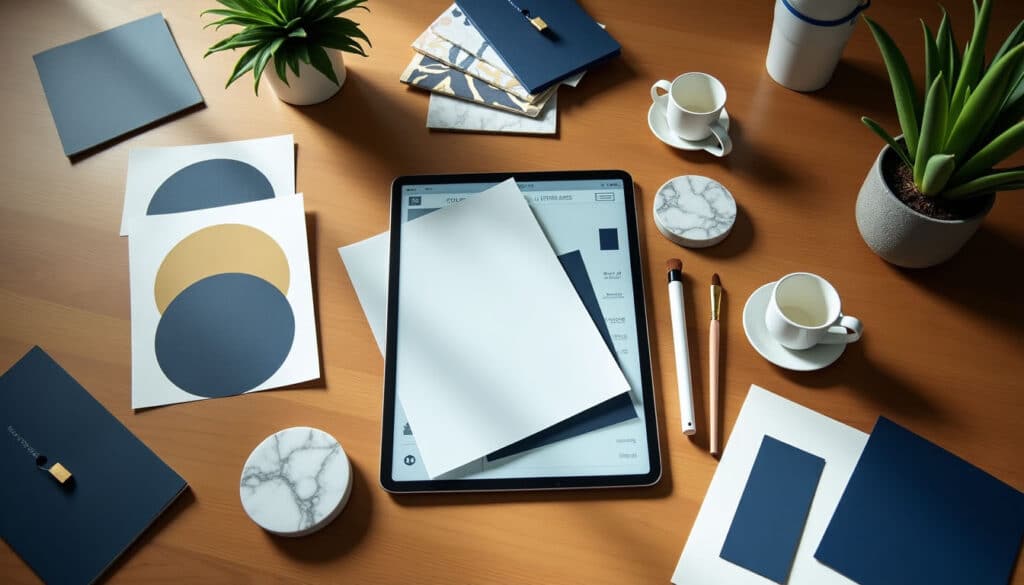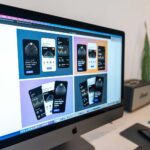
Let’s dive into the world of graphics design services—a game-changer for businesses looking to make a lasting impact in a visually-driven world. Whether you’re a business owner or leading a marketing team, the importance of top-notch design for building your brand’s identity and attracting customers can’t be overstated. From eye-catching logos to attention-grabbing marketing materials, professional graphic design can take your brand from “just another company” to a memorable, must-watch player in the industry. But it’s more than just looking good; it’s about creating a cohesive and memorable visual presence that separates you from the competition.
Ever wonder why certain brands seem to stand out effortlessly? That’s the magic of visual branding. Graphics are the backbone of your brand’s identity, the visual language that tells your audience who you are, what you stand for, and why they should care. It’s more than just colors and logos—think fonts, imagery, and even the smallest design details that all work together to create a lasting impression. Consistency is key here. Whether it’s your business cards, custom graphic design services, website, or social media, every touchpoint should reinforce your brand’s message.

Understanding the Power of Visual Branding
Let’s talk about the unsung hero of your brand: visuals. Whether you’re a business owner, marketing director, or sales executive, you’ve probably heard it a million times—”your brand is more than just a logo.” And it’s true! But that logo, along with your colors, fonts, and imagery, is doing a lot of heavy lifting. It’s shaping how people see and feel about your brand.
Step 1: The Role of Graphics in Brand Identity
Graphics aren’t just about making things look nice; they’re about creating a visual language that tells the world who you are, what you stand for, and why they should care. Professional graphic design services help build this language, crafting a cohesive visual identity that represents your company’s values, personality, and promises.
Think of it like this: your visual identity is your brand’s handshake. It’s the first impression or brand recognition that sticks in people’s minds. Whether it’s the logo they see on your website, the colors in your social media posts, or the typography in your brochures, these elements all work together to create a memorable, recognizable brand image.
Step 2: Consistency is Key for Brand Recognition
In today’s cluttered marketplace, standing out is tough. But that’s where a strong visual identity comes in. A well-crafted, consistent design does more than just catch the eye—it builds trust. People are more likely to remember you and feel confident in your brand when they see a unified look across all platforms.
Graphic design companies know that maintaining this consistency across every touchpoint—from your website and social media to your business cards and email templates—is essential. This visual uniformity reinforces your brand’s message and values, helping you stand out from the competition. The more consistent your visuals, the easier it is for customers to recognize and relate to your brand. Our graphic design Orange County CA team can’t emphasize this enough. Consistency is key!
Step 3: Building Trust and Loyalty
A consistent, high-quality visual identity doesn’t just get you noticed—it creates emotional connections. And when customers feel connected to your brand, that’s when the magic happens. They trust you more, recognize you faster, and keep coming back. That’s brand loyalty, and it starts with how you present yourself visually.
So, if you want to be memorable, build trust, and cultivate long-term loyalty, don’t underestimate the power of professional graphic design. It’s not just about making things pretty; it’s about creating a visual identity that resonates, engages, and leaves a lasting impression.
In the end, our brand identity design Orange County team believes a cohesive visual brand isn’t just an aesthetic decision—it’s a strategic one.
Step 4: Key Elements of Effective Visual Branding
- Logo: This is the heart of your visual identity, the face of your brand. A great logo should be more than just aesthetically pleasing—it should encapsulate your brand’s essence and work seamlessly across every platform.
- Color Palette: Did you know that brand colors can boost recognition by 80%? The right color scheme evokes emotion, builds familiarity, and tells your story without words. (Think about how you feel when you see Coca-Cola red or Nike black-and-white.)
- Typography: Fonts matter. They set the tone and personality of your brand. Whether it’s bold and modern or classic and refined, typography is key to creating a cohesive look and feel.
- Imagery & Iconography: Custom graphics and icons tell your brand’s story in a way words can’t. They help your audience connect emotionally and visually with your brand.
Step 5: How Strong Visuals Impact Customer Perception
Strong visuals have a profound impact on how customers perceive and interact with a brand. Professional graphic design can influence customer behavior and decision-making processes in several ways:
- First impressions: Visual elements create an immediate impact, often forming the basis of a customer’s initial perception of a brand. A striking visual identity can capture attention and leave a lasting impression.
- Emotional connection: Well-crafted visuals can evoke specific emotions and associations, helping to build a deeper connection between the brand and its audience. This emotional bond can lead to increased brand loyalty and trust.
- Brand recognition: Consistent use of visual elements across all platforms reinforces brand identity and improves recognition. This familiarity can give a brand an edge over competitors in the minds of consumers.
- Storytelling: Graphic design serves as a powerful tool for storytelling, allowing brands to communicate their values and mission visually. This visual narrative can resonate with customers on a deeper level, fostering a stronger connection to the brand.
By working with a skilled graphic design agency, you can create a visual identity that resonates with your audience and keeps your brand top of mind.

Must-Have Graphic Design Services for Businesses
So, what kind of graphic design services do businesses really need to stay competitive? Let’s break it down:
Logo design and brand identity packages
A cornerstone of any business’s visual identity is its logo. A full brand identity package or professional graphic design services will give you everything you need to establish a unified look, from color palettes and typography guidelines to iconography. Our logo design Orange County team believes a well-designed logo serves as the foundation for a company’s entire visual branding strategy. Graphic design agencies understand the importance of creating a
versatile logo that works across various platforms and mediums.
Marketing collateral and promotional materials
Graphic design companies are instrumental in creating impactful marketing collateral and promotional materials, which are vital for businesses to effectively communicate their brand message and highlight their products or services. Custom graphic design services can produce a variety of materials, including:
- Brochures and flyers
- Business cards
- Sell sheets or one-pagers
- Presentation decks
- Email templates
- Social media graphics
Each of these assets should not only be visually appealing but also consistently reflect the brand’s identity. Professional graphic designers ensure that the design is both creative and strategic, helping businesses engage their audience and drive conversions.
Web and digital design services
Let’s face it—if your business isn’t making waves online, you’re missing out. Our graphic design services Orange County team believes having a powerful online presence is more than just a luxury; it’s a necessity. And guess what? Your graphic design and website design is at the heart of it all. From stunning websites to engaging digital ads, good design isn’t just eye candy—it’s a business driver.
Think of your website as your digital storefront. It’s often the first impression your customers get, and we all know how much first impressions matter. A well-designed, user-friendly website can make or break that crucial moment.
What Makes a Website Stand Out?
Let’s break it down. There’s more to web design than just picking pretty colors and fonts. You need a site that looks amazing but also works effortlessly. Here are the key players behind the scenes:
- User interface (UI) design: How things look and feel. This is your site’s visual personality.
- User experience (UX) design: How easily your customers navigate and interact with your site. Is it intuitive? Or do visitors bounce out of frustration?
- Responsive design for mobile devices: Let’s not forget mobile. Your site needs to work like a charm on every screen size, from desktop to smartphone.
- Custom illustrations and graphics: Unique visuals that separate you from the cookie-cutter templates out there.
- Website layout and navigation: Simple, smart, and easy-to-follow structures that make browsing a pleasure, not a puzzle.
Design That’s Both Beautiful and Functional? Yes, Please!
The magic happens when you balance aesthetics with functionality. You need a website that not only wows but also converts. And that’s where pro graphic design services step in. Top-notch designers understand that your website has to do more than just “look nice.” It needs to keep visitors engaged, guide them to take action, and ultimately, help you achieve your business goals.
But web design is just the tip of the iceberg. Let’s talk digital design services.
Beyond Websites: The Bigger Digital Picture
If your business is ready to dominate online, you’ll need more than just a pretty site. Professional graphic designers can help build the entire digital ecosystem—from mobile app interfaces that users love to digital ads that stop the scroll. The goal? To create a consistent and cohesive digital presence that perfectly reflects your brand.
When all your digital assets—your website, ads, social media graphics—are aligned with your brand, the results are powerful. It’s like giving your business a unified, polished voice that stands out in a crowded market.
The Bottom Line: Good Design = Good Business
At the end of the day, investing in professional graphic design and website development is a game-changer. It shapes how your brand is perceived, both online and off, and can significantly influence your success. Whether you’re a business owner, a marketing director, or heading up business development, one thing’s for sure: great design gets noticed, and more importantly, it gets results.
So, why leave your online presence to chance? Let the pros help you create a visual identity that sticks, a website that converts, and digital materials that turn heads. After all, in today’s digital world, design isn’t just a service—it’s a smart business move.

Choosing the Right Graphic Design Partner
So, you’re in the market for a graphic design partner. You know, that perfect team to elevate your brand with stunning visuals and creative genius. But how do you find the one—the graphic design agency that really gets your brand, fits your budget, and makes you feel like a rockstar? Well, it’s not just about picking the prettiest portfolio; there’s a bit more to it. Let’s break it down.
Step 1: Know What You’re Looking For
Before you start swiping through design portfolios, take a moment. What exactly do you need? Are you after a full rebrand, a killer website, custom graphic design services or just some polished marketing collateral? Knowing your end game helps you find an agency that specializes in what you need, rather than a jack-of-all-trades that may lack depth.
Step 2: The Portfolio Deep Dive
This is where the magic happens. When reviewing a graphic design agency’s portfolio, you’re not just window shopping for cool visuals—you’re assessing their ability to bring your brand vision to life. Here’s what to look for:
- Range of Projects: Can they handle everything from sleek business cards to dynamic websites? A wide portfolio shows flexibility and creativity across various mediums.
- Quality Over Quantity: It’s not about how many projects they’ve done but how good they are. Are the designs fresh? Do they look like they’ve aged well? You want timeless, not trendy.
- Alignment with Your Brand Style: Can you see your brand fitting into their designs? Look for work that speaks your language—whether it’s bold, minimalist, or cutting-edge.
- Problem-Solving Abilities: Great design isn’t just pretty; it solves problems. Did their work help boost engagement, streamline user experience, or clarify a brand message? Results matter.
- Innovation and Originality: Are they pushing creative boundaries, or are they stuck in a design rut? You want a partner who brings fresh ideas to the table.
- Technical Expertise: It’s all fun and games until you need your design to be print-ready or optimized for web. Make sure their technical chops are as sharp as their creative skills.
Pro tip: Don’t be shy about asking for additional samples or specific details about the designers who’ll be working on your projects. You want to know exactly who’s behind the curtain.
Step 3: Communication is Key
This one’s huge. No matter how talented an agency is, if communication is a struggle, your project is going to feel like pulling teeth. Are they responsive? Do they listen to your ideas? Can they explain design concepts in a way that makes sense?
A good graphic design partner will feel more like an extension of your team than a vendor you have to chase down for updates. Consider the following aspects of communication:
- Responsiveness: How quickly does the agency respond to inquiries?
- Clarity: Are their communications clear and easy to understand?
- Understanding: Can they effectively grasp your needs and objectives?
- Feedback process: How do they handle revisions and incorporate client input?
Look for agencies that prioritize open dialog and have established processes for collaboration. This includes regular check-ins, clear project timelines, and transparent communication about progress and potential challenges.
Step 4: Check Out Their Pricing Models
Budget matters, but don’t go for the lowest bidder without doing your homework. Some agencies charge hourly, some work on flat rates, and others may offer retainer models. The key here is transparency—make sure you know what you’re getting and how they structure costs. Cheap doesn’t always mean good, and high-priced doesn’t guarantee luxury service. It’s about finding that sweet spot of value for your money.
Each model has its advantages and considerations:
- Hourly rates: Typically range from $25 to $150 per hour, depending on the designer’s experience level.
- Project-based pricing: Can vary widely, from $100 to $15,000, based on project complexity and scope.
- Retainer agreements: Involve fixed monthly or annual fees for ongoing design services.
When evaluating pricing, consider the overall value offered by each package. Look beyond the cost to assess the range of services included, the expertise provided, and the potential return on investment for your business.
Step 5: Are They a Good Fit?
This isn’t just about their design skills—it’s about their working style. Do their values align with yours? Do you vibe with their energy? You’ll be spending a lot of time collaborating, so make sure it’s someone you can see yourself working with long-term. Think of it as a professional relationship—you need mutual respect, clear communication, and a little creative chemistry.
Step 6: The Bottom Line
Choosing the right graphic design partner is about finding a balance between creative talent, technical know-how, and a seamless working relationship. Take your time, do your homework, and make sure your chosen agency aligns with your brand vision and goals. When you find the right fit, it’s like magic—designs come to life, your brand shines brighter, and your business stands out in a crowded marketplace.
Ready to start your search? Just remember: great design isn’t just about looking good—it’s about creating impact. Now, go find that dream team!

Maximizing ROI from Graphic Design Investments
Let’s be honest—great design isn’t just about looking good; it’s about doing good for your business. You’re not investing in professional graphic design services just to get some eye candy—you want tangible results. Whether you’re a business owner, marketing director, or sales executive, the key question is: how do you measure the impact of design on your bottom line?
Step 1: Align Design with Your Business KPIs
First things first—what are you measuring? If you want to see a real return on investment (ROI) from graphic design services from your design efforts, you need to tie them directly to your business goals. This means working with your design partner to align creative projects with your key performance indicators (KPIs). When you do this right, you can actually quantify how design is helping move the needle.
For example:
- Increased conversions: A killer website redesign or eye-catching product packaging can lead to higher conversion rates. More clicks, more sales, more revenue. Simple as that.
- Boost in engagement: Are people spending more time on your site or interacting with your social media? Great design can make that happen.
- Revenue growth: At the end of the day, better design should positively impact your bottom line. More engaged customers = more sales.
But it’s not just about the numbers. Don’t forget qualitative metrics like user satisfaction and brand perception. A sleek, intuitive user interface (UI) can improve how customers feel about your brand, turning them from casual browsers into loyal advocates.
Step 2: Quantitative Meets Qualitative—Measure Both!
You’re not just looking at the hard numbers here. Sure, metrics like conversion rates, time on site, and revenue are crucial, but the softer, qualitative stuff is just as important. Ask yourself:
- Are customers happier with your website’s usability?
- Is your brand being perceived as more professional or innovative?
These insights may not always show up in spreadsheets, but they’re the stuff that builds brand loyalty and long-term success. Metrics like Net Promoter Score (NPS) or user satisfaction surveys give you that human feedback that matters just as much as the dollars.
Step 3: Take Design Across Multiple Channels
Now, let’s talk about leverage. If you really want to maximize your design ROI, you need to spread that visual goodness everywhere. I’m talking websites, social media, email campaigns, product packaging—all of it. The more consistent your brand looks across different channels, the stronger your brand recognition will be.
A cohesive visual identity makes it easier for customers to recognize you, whether they’re browsing online, checking their email, or picking up a flyer. And here’s the kicker—businesses that nail this multi-channel approach tend to see an average 9.5% boost in annual revenue. So yeah, it works.
Working with professional creative agencies Orange County CA means they’ll know exactly how to tailor your brand’s visuals to different platforms while keeping everything aligned with your core message. No more copy-paste visuals that feel off—each platform will feel intentional and on-brand.
Step 4: Keep Evolving—Brand Management and Updates
Just because you’ve nailed your design doesn’t mean you’re done. If you want to stay ahead of your competitors, you’ve got to keep things fresh. Design trends shift, consumer preferences evolve, and your brand needs to keep up.
Professional graphic design services aren’t a one-and-done deal—they’re part of an ongoing process. Regularly updating your visuals ensures you’re always ahead of the curve, making your brand feel modern and relevant.
- Monitor brand performance metrics: Keep an eye on how your brand is performing across the board. Are you seeing a dip in engagement? Time to tweak those visuals.
- Adapt to emerging trends: Your design agency should be on top of the latest trends, helping you stay fresh without veering into “trying too hard” territory.
The Bottom Line
Businesses that invest in thoughtful, strategic design see real, measurable results. It’s not just about pretty logos or slick websites—it’s about using design as a tool to drive growth, engagement, and revenue. So, whether you’re looking to boost conversions or build brand loyalty, professional graphic design services is the secret weapon that can take your business to the next level. Just remember, great design doesn’t only make you look good—it makes you perform even better. Now, are you ready to start seeing the impact of design on your business goals? Let’s make it happen!
Ready to elevate your brand? Book a complimentary 15-minute consult today and let’s discuss how our expertise can help you achieve your creative goals. Discover the perfect creative design partnership for lasting impact and market success.
FAQs
What does visual identity mean in the context of graphic design?
Visual identity in high-quality graphic design encompasses the visual aspects that represent a company, organization, or product. This includes logos, color schemes, web design, illustration and animation styles, typography, icons, photography, and the overall esthetic look of the brand.
What are branding and identity in graphic design?
Branding in graphic design refers to the perception others have about your company, product, or service. A well-crafted visual identity is the visual aspect of branding, including elements like logos and color schemes. Strong visuals are crucial as they significantly influence consumer perceptions and experiences.
How significant is graphic design in establishing a brand identity?
Graphic design is vital in forming a brand identity. It goes beyond mere esthetics to become an essential part of branding strategy. It enhances brand recognition, communicates brand values, builds consumer trust, and drives conversions.
How can one develop a strong visual brand identity?
Creating a strong visual brand identity involves careful selection of fonts and shapes, which are fundamental in defining a brand’s visual representation. The choice of fonts, whether modern sans-serif or classic serif, plays a crucial role in conveying the brand’s personality and setting the tone for its communications.























